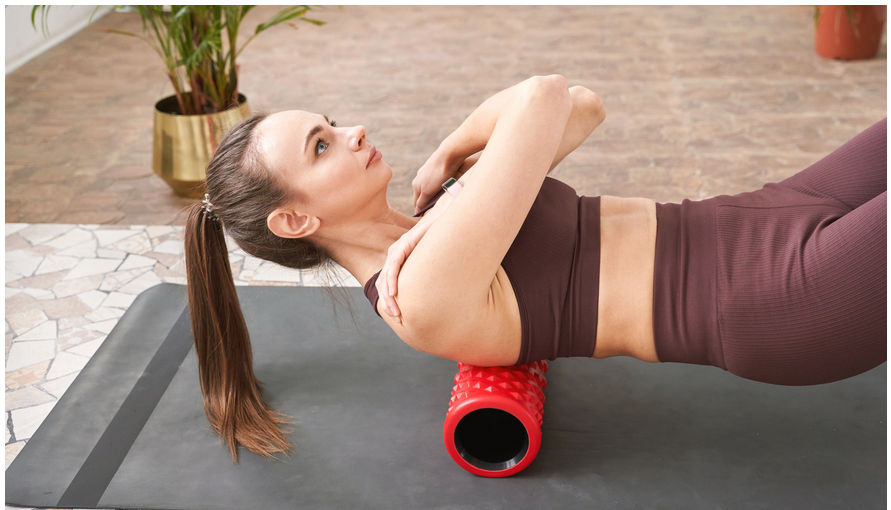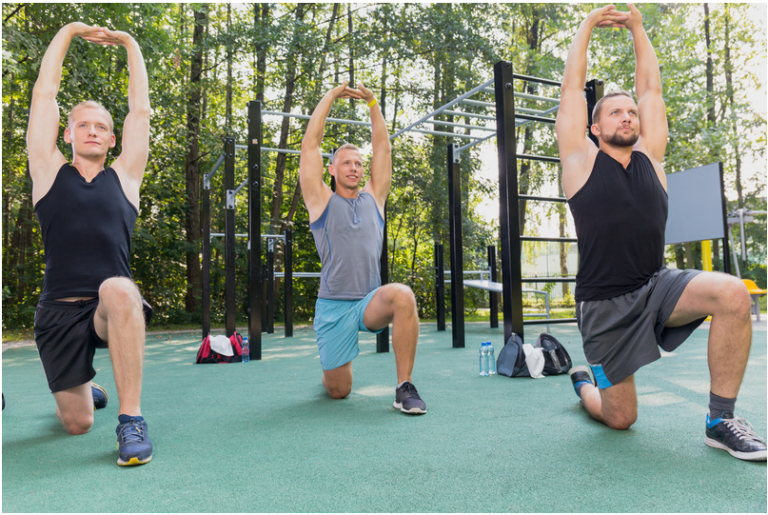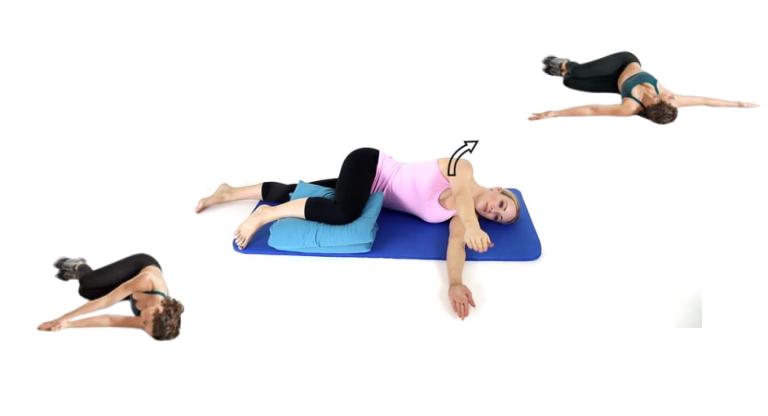
Fascia Stretching Exercises | Unlock Your Flexibility

Ever found yourself grappling with that relentless stiffness in your muscles? You’re stretching, trying all the tricks in the stretch out strap exercises book, yet something still feels locked up tight. Well, it might not just be about the muscles themselves—it’s often about the fascia.
And let me tell you, this thin sheath of connective tissue holds more sway over our flexibility than we might think.
In my journey studying physical therapy and fitness coaching spanning well over ten years, I’ve witnessed quite a few “aha” moments when clients discover the wonders of fascial stretching.
This isn’t just some fleeting fad; it’s an evidence-backed technique steadily gaining its due recognition. Attending to your fascia can ease up those pesky knots that seem immune to everything else while also boosting circulation—a lifeline for muscle vitality and healing.
And here’s an intriguing little nugget: weaving these stretches into your routine could unlock a new level of freedom in how you move. Imagine less discomfort and smoother movement—sounds enticing, right? So why wait any longer? Let’s dive into this together and help you achieve that oh-so-elusive feeling of being perfectly limber!
Key Takeaways
- Stretch your fascia thrice weekly to keep it flexible and prevent stiffness. Hold each stretch for 15 seconds and repeat them to feel better in your body.
- Remember to warm up, stretch too hard, or breathe right. These can hurt you instead of helping.
- If your body hurts or you have an injury, talk to a doctor before starting new stretches. They will tell you what is safe so you don’t get hurt.
What is Fascia, and Why Is It Important?
Fascia is a connective tissue that surrounds and supports the body’s muscles, bones, and organs. It is crucial in maintaining structural integrity, providing stability, and allowing smooth movement.
Understanding the importance of fascia can help us appreciate the value of incorporating stretching exercises to maintain its health and function.
Definition of fascia
Fascia is like a stretchy web that wraps around all the parts inside our bodies – muscles, bones, nerves, and organs. Consider it an inner suit that helps everything stay in place and move smoothly.
This web is mostly made of collagen, which should be soft and flexible to ensure our fascial tissue functions properly. But sometimes, fascia can get dry and tight, making it harder for us to move or feel comfortable, underlining the importance of fascia blasting.
It’s super important because it connects every part of us together. When our fascia is healthy, we can twist, bend, and reach better without pain or stiffness. So, let’s keep our body’s support system happy with some good stretches! Now let’s talk about why stretching out this amazing inner suit can make us feel so much better….
Functions of fascia
Our bodies are amazing, and fascia is like a superhero suit that holds everything together, embodying fascial tissue’s essence. It wraps around our muscles, bones, and organs to keep them in place. This tissue is super important because it helps our muscles move smoothly.
Without it, we’d be stiff and couldn’t dance or jump easily.
Fascia also has another cool job – it separates muscles while keeping them connected. Imagine wearing a stretchy shirt that moves with you; that’s what fascia does for your muscles! It lets them slide past each other without trouble, so you can bend, twist, and reach without feeling stuck.
Benefits of Fascia Stretching Exercises
Fascia stretching exercises offer a range of benefits, including improved flexibility, reduced muscle tension and pain, increased blood flow and circulation, and better posture and range of motion.
Embracing these exercises can enhance your overall mobility and contribute to your health and wellness.
Improved flexibility
We all want to move easily and without pain, right? Fascia stretching exercises can make that happen. They help your muscles glide smoothly as you bend and reach. Think of it like this: when your fascia is tight, your body feels stiff.
But give it a good stretch, and wow – you’ll feel more loose and ready for action!
Now, picture yourself reaching high or bending down without any “ouch” moments – that’s what we aim for with these stretches. By doing them regularly, we can keep our bodies flexible no matter our age or time spent sitting each day.
And hey, who wouldn’t love to move like they did when they were younger? Let’s get those stretches in; our flexibility depends on it!
Reduced muscle tension and pain
Fascia stretching exercises help to reduce muscle tension and pain. It can alleviate stiffness and knots in the muscles, relieving discomfort. By increasing circulation, these exercises can also aid in reducing myofascial or muscular pain.
This means that regular fascia stretching can help address tightness that might be causing strain and discomfort throughout your body.
These exercises are especially beneficial for those experiencing lower back pain or tightness in specific areas such as the thighs, hips, and calves. With consistent practice of recommended fascia stretching exercises like foam rolling for the upper and lower back or standing hip flexor stretch, you can experience a significant reduction in muscle tension and discomfort with improved flexibility overall.
Increased blood flow and circulation
Reduced muscle tension and pain are great benefits of fascia stretching, but let’s discuss another important advantage – increased blood flow and circulation. Daily stretching can help with this one.
When you stretch your muscles, it increases the blood flow to them. That means more oxygen gets to your muscles, nutrients, and a way to eliminate waste products. It can also speed up recovery after exercise and reduce the chances of getting hurt.
Fascial stretching is good at improving blood flow, which helps in reducing pain throughout the body.
Improved circulation from stretching isn’t just a nice-to-have bonus; it’s important for your overall health! It reduces the risk of pain and injury by delivering more oxygen and nutrients to your muscles while removing waste products that could lead to inflammation or tightness.
Better posture and range of motion
Fascia stretching exercises are crucial in improving posture and increasing range of motion. By releasing muscle tension and strengthening joints, these exercises can significantly enhance flexibility and support better posture.
This gentle approach improves mobility and helps maintain a proper range of motion while supporting fascial health. Through strengthening and stretching exercise programs, individuals can experience reduced pain, improved gait, and overall physical function.
Incorporating these simple yet effective fascia stretching exercises into your routine can lead to better posture, increased flexibility, and enhanced overall physical function. It’s important to remember that consistency is key when reaping the benefits of improved posture and range of motion through regular fascia stretching exercises.
Recommended Fascia Stretching Exercises
Try incorporating exercises such as the heel sit, downward-facing dog, standing hip flexor stretch, foam rolling for the upper and lower back, and various yoga poses to improve flexibility and reduce muscle tension.
Please keep reading for more detailed information on how to perform these exercises and their benefits!
Heel sit
Heel sit is a great stretch for the plantar fascia and calf muscles. You start kneeling with your knees bent and shins parallel to the floor, then sit back on your heels. This exercise can help increase flexibility and reduce heel pain, especially for conditions like plantar fasciitis.
Experts recommend to soothe chronic heel pain and improve gait. So, if you’re dealing with persistent heel discomfort, incorporating heel sits into your stretching routine could make a real difference in how you feel.
It’s important to note that this is only one of several effective exercises that can help alleviate tightness and tension in the fascia throughout your body. Each exercise offers unique benefits contributing to overall mobility, comfort, and well-being, especially when keeping your fascia soft and flexible.
Downward-Facing Dog
Downward-Facing Dog is a great way to stretch the fascia in your body. This yoga pose helps improve flexibility and increase blood flow. It focuses on stretching the back of your legs, especially the tight hamstrings and calf muscles, which can cause discomfort.
Holding the pose for 90 to 120 seconds is important for maximum benefit when doing a Downward-Facing Dog. This time encourages myofascial release, reducing muscle tension and promoting flexibility.
So, let’s move on to our next recommended exercise, “Standing hip flexor stretch,” which will help you further enhance your fascia stretching routine.
Standing hip flexor stretch
We recommend the standing hip flexor stretch to lengthen tight hip flexor muscles and ease back, core, and glute tension. This exercise can improve flexibility and help with better posture and range of motion, allowing you to feel a stretch throughout your body.
When doing this stretch, remember to target both the hip flexors and opposing muscle groups for a well-rounded approach that avoids overstretching.
Stand upright with your:
Foam rolling for the upper and lower back.
Foam rolling can alleviate muscle pain and help with sore muscles in the upper and lower back. It reduces muscle tension and knots and contributes to better posture, largely due to its effects on the fascial tissue. Consistent foam rolling improves muscular performance, flexibility, and stretch tolerance.
It’s also great during warm-up to enhance flexibility and can be particularly helpful for people with sore upper and lower back muscles.
Incorporating foam rolling into your routine may reduce pain, increase blood flow, and improve upper and lower back circulation while enhancing overall mobility.
Various types of yoga poses
After foam rolling for the upper and lower back, we can move into various yoga poses recommended for maintaining healthy fascia and promoting flexibility. Yoga poses, such as the extended side angle pose, help build strength and effectively stretch the fascia.
Additionally, styles like Hatha or Yin yoga are beneficial for keeping fascia healthy and flexible. These types of yoga aid in deeply stretching the fascia to alleviate back pain, sciatica, and tightness while improving overall flexibility.
Embracing these yoga practices can be immensely helpful in ensuring a strong and supple fascial system.
How Often Should You Stretch and Avoid Common Mistakes

Regarding how often you should stretch, consistency is key – aim for at least 2-3 times per week. And remember to avoid common mistakes such as stretching too aggressively or holding your breath – click here for more tips and recommendations!
Recommended frequency of stretching
We should aim to do fascia stretching exercises three times a week for the best results. Spending 60 seconds on each stretching exercise and holding each stretch for 15 seconds can help improve our range of motion and flexibility.
Remember, consistency is key when reaping the benefits of fascia stretching.
Sticking to a regular schedule and following these recommended guidelines can effectively release muscle tension, improve blood circulation, and promote better posture.
Mistakes to avoid
After understanding the recommended frequency of stretching, it’s essential to be aware of common mistakes that can hinder the effectiveness of your fascia stretching routine. Here are seven things to be mindful of:
Consulting a doctor for chronic pain or injuries
If you have chronic pain or injuries, it’s crucial to consult a doctor before starting any new stretching exercises. This is especially important to ensure that the stretching won’t worsen your condition and to receive guidance on the appropriate level of physical activity for your situation.
It’s essential to seek professional advice, particularly if you’re dealing with chronic pain or if you’ve incurred injuries related to stretching.
Remember, hypermobile joints may require special attention and supervision from a qualified healthcare practitioner regarding stretching activities. Always prioritize your safety and well-being by seeking medical guidance when needed.
Conclusion
Fascia stretching exercises help release tight fascia, reducing muscle knots and stiffness. These exercises improve mobility and flexibility and should be part of your fitness routine for better physical performance.
They benefit individuals of all ages, including seniors, by enhancing flexibility and reducing stiffness, helping you stretch your entire body. Furthermore, they can alleviate lower back pain and improve overall musculoskeletal health.
FAQs
What’s the scoop on fascia stretching exercises?
Well, let me tell you! Fascia stretching exercises are about loosening that fibrous connective tissue wrapping your muscles and organs. It helps keep everything moving right and can boost athletic performance to boot!
Can I do fascia stretches at home?
Absolutely! Just roll out a yoga mat or hop on a comfy spot – no feel this stretch with or without fancy gear. Whether you want to target that tricky back leg or give your upper back some love, there’s a stretch for every spot.
How does stretching my fascia help with pain in my lower back?
When your fascia gets as tight as last year’s jeans, it can lead to a lot of ouch—especially in the lower back area. Stretching it out gently can make things feel way better.
I’ve heard something about this “fascia miracle” – what’s up with that?
Oh, the “fascia miracle”? Sounds fancy, huh? But really, it’s when you get into the groove of regular stretching and suddenly—bam! Your body feels more flexible than ever before.
If I sit too much at work, should I be doing these fascial stretches?
Spending too much time sitting is like an open invitation to tighten the city (yikes!). So why not show some self-love by trying fascial stretch therapy today? Stand up, reach toward those toes, or lean against a wall; keep that elasticity going!
Are there special stretch moves just for beginners like me?
Absolutely! Start easy with gentle neck rolls, or place your left hand behind your head—and go slow, okay? Before you know it, you’ll master those moves and keep tightness at bay.



